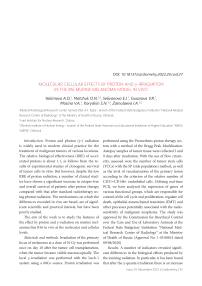Molecular cellular effects by proton and у-irradiation in the B16 murine melanoma model in vivo
Автор: Yakimova A.O., Matchuk O.N., Selivanova E.I., Gusarova V.R., Mosina V.A., Koryakin S.N., Zamulaeva I.A.
Журнал: Cardiometry @cardiometry
Рубрика: Conference proceedings
Статья в выпуске: 29, 2023 года.
Бесплатный доступ
Proton and photon (γ-) radiation is widely used in modern clinical practice for the treatment of malignant tumors of various locations. The relative biological effectiveness (RBE) of accelerated protons is about 1.1, as follows from the results of experimental studies of clonogenic survival of tumor cells in vitro. But however, despite the low RBE of proton radiation, a number of clinical studies have shown a significant increase in relapse-free and overall survival of patients after proton therapy compared with that after standard radiotherapy using photon radiation.
Proton therapy, γ-radiation, tsc, vascularization, gene expression
Короткий адрес: https://sciup.org/148327399
IDR: 148327399 | DOI: 10.18137/cardiometry.2023.29.conf.27
Текст статьи Molecular cellular effects by proton and у-irradiation in the B16 murine melanoma model in vivo
1Medical Radiological Research Center named after. A.F. Tsyba - branch of the Federal State Budgetary Institution “National Medical
Research Center of Radiology” of the Ministry of Health of Russia, Obninsk;
2Joint Institute for Nuclear Research, Dubna;
3Obninsk Institute of Nuclear Energy - branch of the Federal State Autonomous Educational Institution of Higher Education “NRNU “MEPhI”, Obninsk
Introduction . Proton and photon (γ-) radiation is widely used in modern clinical practice for the treatment of malignant tumors of various locations. The relative biological effectiveness (RBE) of accelerated protons is about 1.1, as follows from the results of experimental studies of clonogenic survival of tumor cells in vitro. But however, despite the low RBE of proton radiation, a number of clinical studies have shown a significant increase in relapse-free and overall survival of patients after proton therapy compared with that after standard radiotherapy using photon radiation. The mechanisms, on which the differences recorded in vivo are based, are of significant scientific and practical interest, but have been poorly studied.
The aim of the work is to study the features of the effect by proton and γ-radiation on murine melanoma line B16 in vivo at the molecular and cellular levels.
Materials and methods. Irradiation of the primary focus of melanoma at a dose of 10 Gy was performed once on day 10 after the tumor cell transplantation, when the tumor became visible macroscopically. The local γ-irradiation was performed with the Luch-1 system using a 60Co source. Proton irradiation was performed using the Prometheus proton therapy system with a method of the Bragg Peak Modification. Autopsy samples of tumor tissue were collected 2 and 9 days after irradiation. With the use of flow cytometry, assessed were the number of tumor stem cells (TCCs) with the SP (side population) method, as well as the level of vascularization of the primary lesion according to the criterion of the relative number of CD31+CD146+ endothelial cells. Utilizing real-time PCR, we have analyzed the expression of genes of various functional groups, which are responsible for control of the cell cycle and proliferation; regulate cell death, epithelial-mesenchymal transition (EMT) and other processes potentially associated with the radiosensitivity of malignant neoplasms. The study was approved by the Commission for Bioethical Control over the Care and Use of Laboratory Animals at the Federal State Budgetary Institution “National Medical Research Center of Radiology” at the Ministry of Health of Russia (Approval No. 1-SI-00014 dated 09/08/2020).
Results. A number of indicators revealed significant differences in the biological effects produced by the ionizing radiation. In particular, it has been found that after the γ-quanta irradiation there is an increase in the relative amount of TSCs 2 days after irradiation (p < 0.01 according to the Mann-Whitney test), while after exposure to protons such an effect is not available. The relative number of CD31+CD146+ endothelial cells in samples taken on day 2 after irradiation is statistically higher after the γ-irradiation compared to that after the action of accelerated protons (p=0.056). It is noteworthy that changes in the expression profile of genes involved in the regulation of stem cell properties and EMT are generally consistent with the quantitative changes in TSCs.
Conclusion . The data obtained allow us to conclude that the specific effects made by proton and photon radiation on the pool of TSCs and the vascularization of the primary tumor site may, at least partially, explain the differences in the clinical effectiveness of these types of ionizing radiation. The scientific and practical significance of the discovered effects is discussed in the report.


